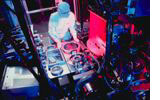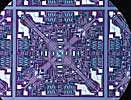Metallization
- Metal Deposition
-

After devices have been fabricated in the silicon substrate, connections must be made to link the circuits together. This process is called metallization. Metal layers are deposited on the wafer to form conductive pathways. The most common metals include aluminum, nickel, chromium, gold, germanium, copper, silver, titanium, tungsten, platinum, and tantalum. Selected metal alloys may also be used. Metallization is often accomplished with a vacuum deposition technique. The most common deposition processes include filament evaporation, electron-beam evaporation, flash evaporation, induction evaporation, and sputtering.
Filament Evaporation
Filament evaporation, also called resistive evaporation, is the simplest method. This process is usually carried out in a bell jar, in which a filament is heated by thermal resistance. As the temperature rises, the metal to be deposited is melted and wets the filament. The current through the filament is increased further, until the metal vaporizes. The metal vapor then condenses on the cooler surface of the semiconductor wafers, forming the desired metal layer.
Electron-Beam Evaporation
Electron-beam evaporation, frequently called "e-beam," uses a focused beam of electrons to heat the metal for deposition. The metal is kept in a water-cooled crucible and exposed to the electron beam, causing it to vaporize and condense on the wafers.
Flash Evaporation
In flash evaporation, a ceramic bar is heated by thermal resistance. Wire is continuously fed from a spool until it contacts the heated bar. Upon contact, the metal evaporates and is deposited on the substrate.
Induction Evaporation
Induction evaporation uses radiofrequency radiation to evaporate the metal in a crucible. The metal is then deposited as with other methods.
Sputtering
To perform sputtering, ions of an inert carrier gas (such as argon) are introduced into a low-pressure or
partial-vacuum atmosphere. An electric field is used to ionize the atoms and draw them to one place in the chamber called the target. The target is comprised of the metal used for deposition. When the ions strike the target, they dislodge, or sputter, these metal atoms. The dislodged atoms are then deposited in a thin film on the silicon substrate facing the target. Sputtering can be done using both direct current and radiofrequency voltages and can be used to deposit almost any material.The following are the potential hazards of metal deposition.
Metals and Solvents
Potential Hazard
- Possible employee exposure to metals and solvents during evaporator cleaning and maintenance operations. Typical metal exposures include silver. Methanol is a popular cleaning solvent.
Possible Solutions
- See Possible Solutions: Solvents.
- Substitute mechanical cleaning methods with chemical methods to help reduce exposures to metals.
Additional Information
- Toxic Metals. OSHA Safety and Health Topics Page.
- Photolithography
-

Similar photolithographic techniques that are used during device fabrication are used to deposit conductive patterns during metallization. In one technique, the metal is deposited then covered with a patterned photoresist, and subsequently etched. In another method the resist is applied first, followed by deposition of the metal. The wafer is then placed in a solvent that causes swelling of the resist. As the resist swells it lifts the overlaid metal away from the wafer surface.
The following are the potential hazards of photolithography.
Photoresist Chemicals
Potential Hazard
- Possible employee exposure to photoresist chemicals.
Possible Solutions
- Identify chemical hazards and perform appropriate exposure evaluations.
- Perform exposure measurements for the chemicals used.
- 29 CFR 1910.1000 Table Z-1 contains permissible exposure limits for various chemicals.
- Address all dermal exposures.
- Provide appropriate ventilation to reduce chemical concentration levels in the air.
- Provide PPE as appropriate to prevent eye and skin contact. [29 CFR 1910 Subpart I]
- Use respiratory protection when necessary to further reduce exposure and protect employees. [29 CFR 1910.134]
- Design and use specialized processing, material handling, and storage equipment to properly contain chemicals. Consider both normal use and emergency scenarios.
- Install emergency facilities to provide immediate treatment in the event of an accidental exposure to corrosive materials. According to 29 CFR 1910.151, provide suitable facilities for quick drenching or flushing of the eyes and body for immediate emergency use whenever the eyes or body may be exposed to corrosive materials.
Additional Information
- Occupational Health Guidelines for Chemical Hazards. US Department of Health and Human Services (DHHS), National Institute for Occupational Safety and Health (NIOSH) Publication No. 81-123, (1981, January). Provides a table of contents of guidelines for many hazardous chemicals. The files provide technical chemical information, including chemical and physical properties, health effects, exposure limits, and recommendations for medical monitoring, personal protective equipment (PPE), and control procedures.
OSHA Safety and Health Topics Pages:
- Dermal Exposure
- Medical and First Aid
- Personal Protective Equipment (PPE)
- Respiratory Protection
- Sampling and Analysis
- Ventilation
Flammable Liquids, Fire
Potential Hazard
- Possible ignition of flammable liquids resulting in fire and/or explosion. Employees may also be exposed to vapors above permissible limits.
Possible Solutions
- Identify and eliminate possible ignition sources. Use a Process Hazard Analysis (PHA) for identifying and controlling such hazards.
- Provide appropriate ventilation to reduce vapor concentration levels in the air.
- Use respiratory protection when necessary to further reduce exposure and protect employees. [29 CFR 1910.134]
- Use appropriate material handling and storage equipment designed for use with flammable liquids.
Additional Information
OSHA Safety and Health Topics Pages:
- Silyation
-
Etching deposited metals requires a more aggressive chemical attack than etching SiO2 during device fabrication. Consequently, the resists need to be tougher. The process of silyation is frequently performed to harden the photoresist before it is subjected to etching. During silyation, silicon atoms are introduced into the surface of the organic resist. This process can be accomplished with either wet or dry procedures. Most commonly, a wet bath using either hexamethyldisilazane (HMDS) or silazone in xylene is used.
The following are the potential hazards of silyation.
- Metal Etch
-

Reactive ion etching (RIE) is commonly used to etch metal layers. This process uses a combination of physical sputtering and chemically reactive species for etching at low pressures. RIE uses ion bombardment to achieve directional etching and a chemically reactive gas (carbon tetrafluoride, carbon tetrachloride, boron trichloride, and others) to maintain good etched layer selectivity. A wafer is placed into a chamber and given a negative electrical charge. The chamber is heated and brought to a low pressure, and then filled with a positively charged plasma of the reactive gas. The opposing electrical charges cause the rapidly moving plasma molecules to align themselves and strike the wafer surface vertically, thereby reacting with and volatizing the exposed metal layer. After etching, the remaining photoresist is stripped in a similar manner as during Device Fabrication.
The following are the potential hazards of metal etching.
Reactive Gases
Potential Hazard
- Possible employee exposure to chlorinated and other reactive gases used for reactive ion etching.
Possible Solutions
- Identify gas hazards and perform appropriate exposure evaluations.
- Identify and evaluate all potential exposure scenarios, for example: startup, operations, maintenance, cleaning, emergencies, and so forth.
- 29 CFR 1910.1000 Table Z-1 contains permissible exposure limits for various substances.
- Provide appropriate ventilation to reduce gas concentration levels in the air.
- Provide PPE as appropriate to prevent contact with gases. [29 CFR 1910 Subpart I]
- Use respiratory protection when necessary to further reduce exposure and protect employees. [29 CFR 1910.134]
- Use gas monitoring systems with automatic shut-offs and alarm systems, as appropriate.
- Design and use specialized processing, material handling, and storage equipment for gases. Consider both normal use and emergency scenarios. Process Safety Management (PSM) requirements may also apply. [29 CFR 1910.119]
Additional Information
OSHA Safety and Health Topics Pages:
- Alloying and Annealing
-
After the metallized interconnections have been deposited and etched, a final step of alloying and annealing may be performed. To perform alloying, the metallized substrate is placed in a low-temperature diffusion furnace. Usually aluminum is placed in the furnace to form a low-resistance contact between the aluminum metal and silicon substrate. Finally, either during the alloy step or following it, the wafers are often exposed to a gas mixture containing hydrogen in a diffusion furnace at 400-500ºC. This annealing step is designed to optimize and stabilize the characteristics of the device by combining hydrogen with uncommitted atoms at or near the silicon-silicon dioxide interface.
The following are the potential hazards of alloying and annealing.
Metals
Potential Hazard
- Possible employee exposure to various metals, aluminum being the most common.
Possible Solutions
- Identify metal hazards and perform appropriate exposure evaluations.
- Perform exposure measurements for the compounds used.
- Keep exposures below acceptable exposure levels.
- Address all dermal exposures.
- Provide appropriate ventilation to reduce metals concentration levels in the air.
- Provide PPE as appropriate to prevent contact. [29 CFR 1910 Subpart I]
- Use respiratory protection when necessary to further reduce exposure and protect employees. [29 CFR 1910.134]
- Maintain adequate housekeeping to remove unwanted metals and reduce concentration levels.
Additional Information
OSHA Safety and Health Topics Pages:
- Passivation
-
Silicon nitride is often used as a final passivating or protective layer for silicon devices. Passivation is accomplished with a chemical vapor deposition process using silane and ammonia gases. Sometimes a layer known as "p-glass" is deposited with a layer of SiO2 doped with phosphorous. Phosphine gas is used as a source for phosphorous for this type of deposition.
The following are the potential hazards of passivation.
Toxic Gases
Potential Hazard
- Possible employee exposure to toxic gases. Typical gases include silane, ammonia, and phosphine.
Possible Solutions
- Identify gas hazards and perform appropriate exposure evaluations.
- Perform exposure measurements for the chemicals used.
- 29 CFR 1910.1000 Table Z-1 contains permissible exposure limits for various chemicals.
- Provide appropriate ventilation to reduce concentration levels in the air.
- Provide PPE as appropriate to prevent eye and skin contact. [29 CFR 1910 Subpart I]
- Use respiratory protection when necessary to further reduce exposure and protect employees. [29 CFR 1910.134]
- Use gas monitoring systems with automatic shut-offs and alarm systems, as appropriate.
- Design and use specialized processing, material handling, and storage equipment for gases. Consider both normal use and emergency scenarios.
- Reduce gas cylinder inventories and quantity of gas per cylinder, when possible.
Additional Information
- Occupational Health Guidelines for Chemical Hazards. US Department of Health and Human Services (DHHS), National Institute for Occupational Safety and Health (NIOSH) Publication No. 81-123, (1981, January). Provides a table of contents of guidelines for many hazardous chemicals. The files provide technical chemical information, including chemical and physical properties, health effects, exposure limits, and recommendations for medical monitoring, personal protective equipment (PPE), and control procedures.
OSHA Safety and Health Topics Pages:
- Backlapping and Backside Metallization
-
A final processing step called backlapping is sometimes performed. The backside of the wafer may be lapped or ground down using a wet abrasive solution under pressure. Backside metallization with a metal such as gold may be deposited on the back of the wafer with sputtering. This makes attachment of the separated die to the package easier in the final assembly.
The following are the potential hazards of backlapping and backside metallization.
Metals
Potential Hazard
- Possible employee exposure to metals used for backside metallization.
Possible Solutions
- Identify metal hazards and perform appropriate exposure evaluations.
- Perform exposure measurements for the compounds used.
- Keep exposures below acceptable exposure levels.
- Address all dermal exposures.
- Provide appropriate ventilation to reduce concentration levels in the air.
- Provide PPE as appropriate to prevent contact. [29 CFR 1910 Subpart I]
- Use respiratory protection when necessary to further reduce exposure and protect employees. [29 CFR 1910.134]
- Maintain adequate housekeeping to remove unwanted metals and reduce concentration levels.
Additional Information
OSHA Safety and Health Topics Pages:

